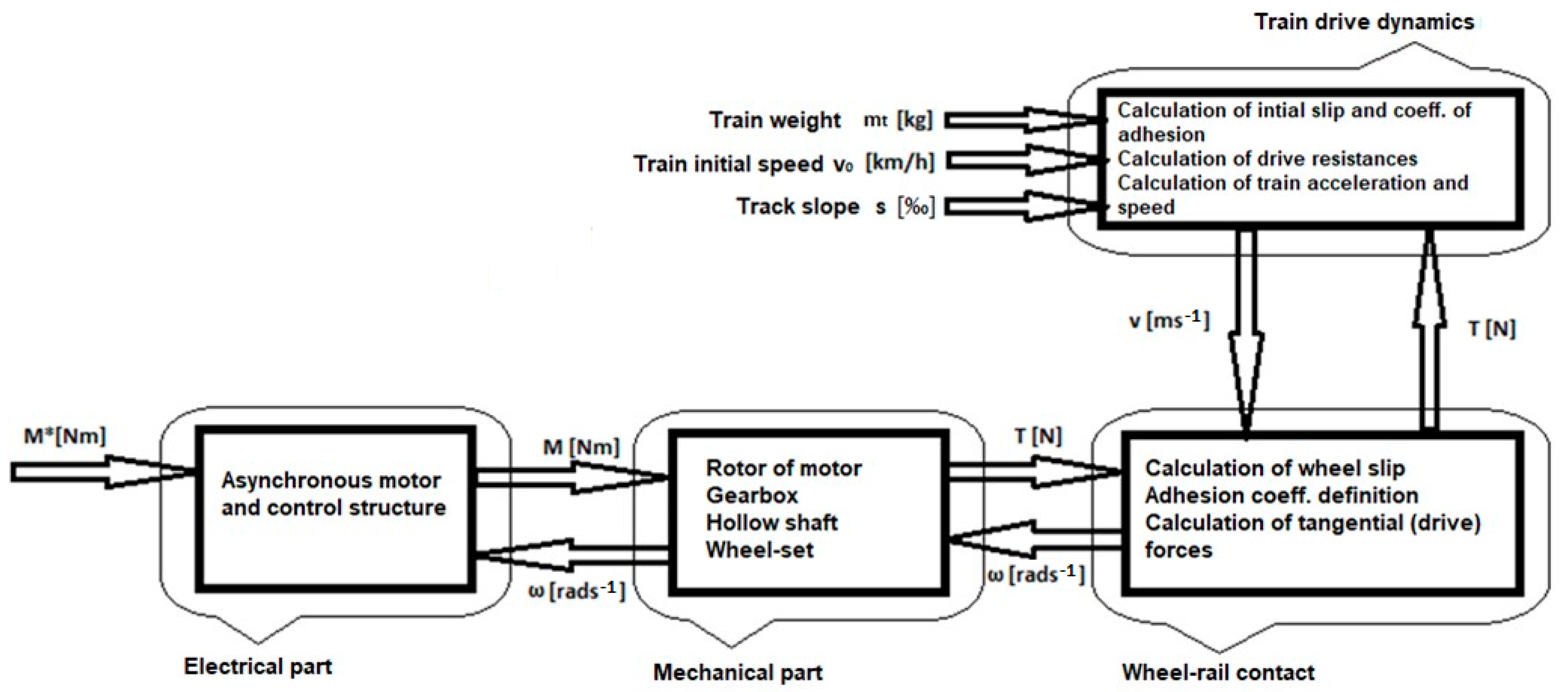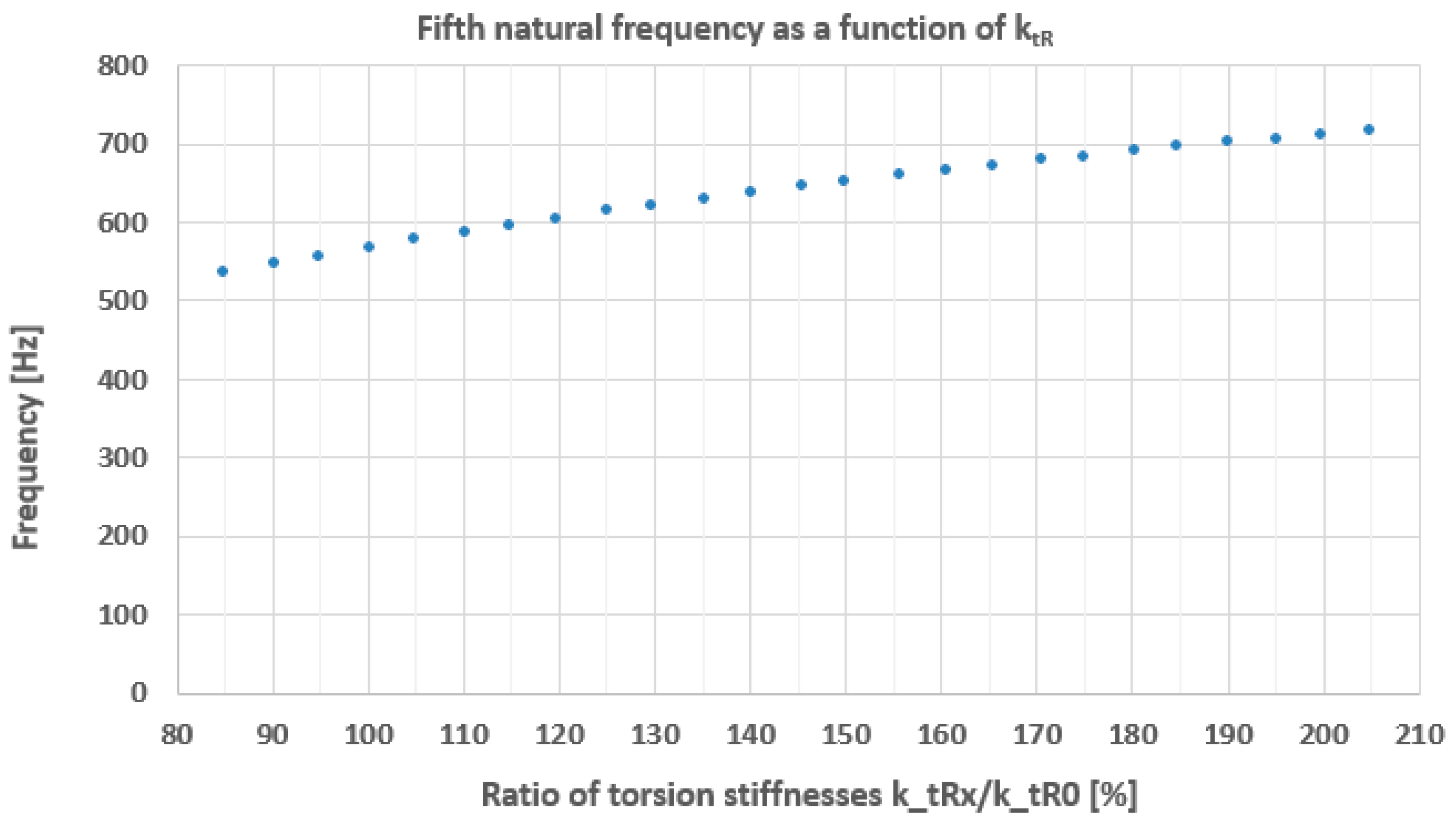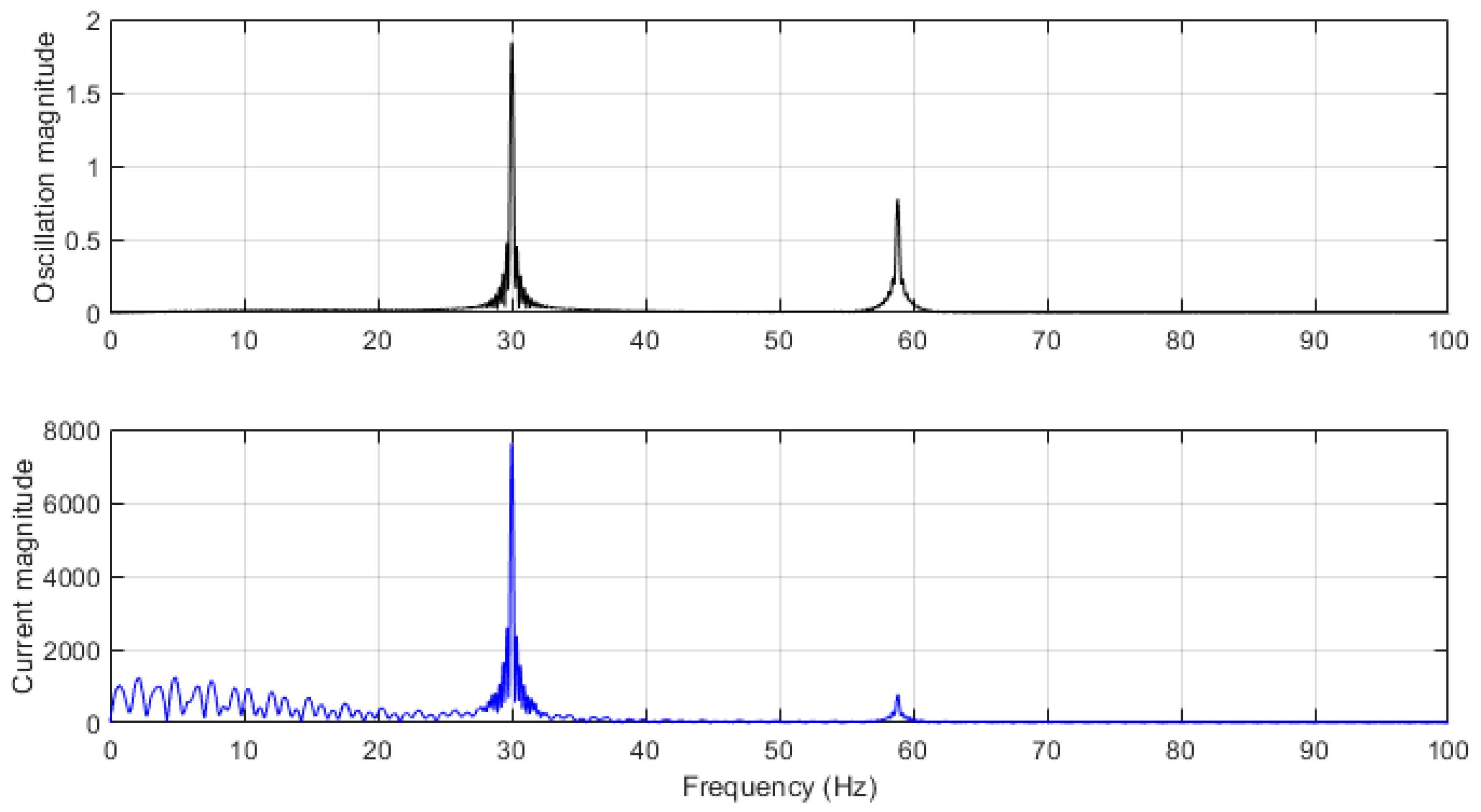The Individual Drive of a Wheelset and the Problematics of Its Electromechanical Phenomena
Abstract
:1. Introduction
2. Object of Interest
2.1. Simulation Model of the Wheelset Drive
2.1.1. Mechanical Part
- rotor of the traction motor,
- gearbox with a pinion and a gearwheel,
- hollow shaft with elastic articulations/clutch/coupling,
- wheelset consisting of an axle and wheels.
2.1.2. Electrical Part—Generation and Control of Torque
2.1.3. Wheel-Rail Contact—Adhesion Model
2.1.4. Train Drive Dynamics—Velocity Calculation
2.2. Simulation Model of the Vehicle
3. Simulation Results
3.1. Electromagnetic Excitation and Torsion Vibrations
- For odd multiples of the switching frequency fPWM:where: f1 is the first harmonic of the supply voltage,(i = 1, 2, 3, …); (k = 1, 3, 5, …); (l = 1, 2, 3, 4, …);
- For even multiples of the switching frequency fPWM:where: (i = 1, 2, 3, …); (m = 2, 4, 6, …); (n = 0, 1, 2, 3, …)
- III—resonance of the fifth eigenfrequency with the frequency sideband of the switching frequency fPWM.
- V—resonance of the seventh eigenfrequency with the frequency sideband of the third multiple of the switching frequency fPWM.
3.2. Phenomena Occurring during Loss of Adhesion
- the wheelset loses its adhesion instantly (prestressed components such as an axle may quickly release its torsion energy);
- the wheelset loses its adhesion gradually (energy accumulated in the wheelset is gradually released).
3.3. Simulations of Vehicle Model
4. Conclusions
Author Contributions
Funding
Data Availability Statement
Acknowledgments
Conflicts of Interest
References
- Kadeřávek, P.; Pernička, J. Torsion oscillations of powered wheelsets. Railvolution 2013, 7, 34–37. [Google Scholar]
- Anand, P. Coning of Wheels in Railways: Theory and Purpose. Available online: https://civildigital.com/coning-wheels-railways-theory-purpose/ (accessed on 22 June 2023).
- Markovic, P.; Kostic, D.; Bojovic, N. One Method for Detection of Torsional Oscillations of Driving Axles of Electrical Locomotives. In Proceedings of the PRORAIL 2015—XXII. Medzinárodná Konferencia Súčasné Problémy v Koľajových Vozidlách, Žilina, Slovakia, 16–18 September 2015; Žilinská Universita, Strojnická Fakulta: Žilina, Slovakia, 2015; Volume 2, pp. 27–37. [Google Scholar]
- Trimpe, F.; Lück, S.; Naumann, R.; Salander, C. Simulation of Torsional Vibration of Driven Railway Wheelsets Respecting the Drive Control Response on the Vibration Excitation in the Wheel-Rail Contact Point. Vibration 2020, 4, 30–48. [Google Scholar] [CrossRef]
- Kondo, K. Anti-slip Control Technologies For the Railway Vehicle Traction. In Proceedings of the 2012 IEEE Vehicle Power and Propulsion Conference, Seoul, Republic of Korea, 9–12 October 2012; pp. 1306–1311. [Google Scholar] [CrossRef]
- Sebesan, I.; Mitu, A.; Sireteanu, T. On the stick-slip phenomena in traction railway vehicles. Proc. Rom. Acad. Ser. A 2015, 16, 209–2016. [Google Scholar]
- Wu, G.; Shen, L.; Yao, Y.; Song, W.; Huang, J. Determination of the dynamic characteristics of locomotive drive systems under re-adhesion conditions using wheel slip controller. J. Zhejiang Univ. A 2023, 24, 722–734. [Google Scholar] [CrossRef]
- Reitmeier, D.; Mertens, A. Active Reduction of Gear Mesh Vibrations by Drive Torque Control. In Proceedings of the 2023 IEEE International Conference on Mechatronics (ICM), Loughborough, UK, 15–17 March 2023. [Google Scholar] [CrossRef]
- Fleischer, M. Modal State Control in the Frequency Domain for Active Damping of Mechanical Vibrations in Traction Drive-Trains. In Proceedings of the 8th IEEE International Workshop on Advanced Motion Control, 2004. AMC ’04, Kawasaki, Japan, 28 March 2004. [Google Scholar]
- Abouzeid, A.; Trimpe, F.; Lück, S.; Traupe, M.; Guerrero, J.; Briz, F. Co-Simulation-Based Verification of Torsional Vibration Protection of Electric-Driven Railway Vehicle Wheelsets. Vibration 2020, 5, 613–627. [Google Scholar] [CrossRef]
- Sadr, S.; Khaburi, D.; Rodriguez, J. Predictive Slip Control for Electrical Trains. IEEE Trans. Ind. Electron. 2016, 63, 3446–3457. [Google Scholar] [CrossRef]
- Hajano, F.; Abro, F.; Memon, T.; Kalwar, I.; Burhan. Fuzzy Logic based Anti-Slip Control of Commuter Train with FPGA Implementation. Int. J. Adv. Comput. Sci. Appl. 2020, 11, 293–300. [Google Scholar] [CrossRef]
- Breuer, W.; Yu, M. Energie-Methode: Vorhersage des maximalen dynamischen Torsionsmomentes. In Proceedings of the 16. Internationale Schienenfahrzeugtagung Dresden, Dresden, Germany, 12–14 September 2018. [Google Scholar]
- Liu, J.; Zhao, H.; Zhai, W. Mechanism of self-excited torsional vibration of locomotive driving system. Front. Mech. Eng. China 2010, 5, 465–469. [Google Scholar] [CrossRef]
- Qi, Y.; Dai, H. Influence of motor harmonic torque on wheel wear in high-speed trains. J. Rain Rapid Transit 2020, 234, 32–42. [Google Scholar] [CrossRef]
- Spangenberg, U.; Fröhling, R. Solving locomotive wheel polygonization by reducing variable frequency drive interharmonics. Proc. Inst. Mech. Eng. Part F J. Rail Rapid Transit 2021, 235, 73–82. [Google Scholar] [CrossRef]
- Winterling, M. Oscillations in Rail Vehicle Traction Drives, Analysis of Electromechanics. Ph.D. Thesis, Delft University, Delft, The Netherlands, 1997; p. 193. [Google Scholar]
- Szolc, T.; Konowrocki, R.; Michajlow, M.; Pregowska, A. An investigation of the dynamic electromechanical coupling effects in machine drive systems driven by asynchronous motors. Mech. Syst. Signal Process. 2014, 49, 118–134. [Google Scholar] [CrossRef]
- Schneider, R. Torsionsschwingungen von Radsatzwellen—Systemanalyse Teil 1: System-und Modellbeschreibung. ZEVrail 2017, 141, 452–461. [Google Scholar]
- Schneider, R. Torsionsschwingungen von Radsatzwellen—Systemanalyse Teil 2: Physikalische Untersuchungen und Sicherheitsbetrachtung. ZEVrail 2018, 142, 27–39. [Google Scholar]
- Takahashi, A.; Sugimoto, S.; Tamiya, S.; Fujii, K.; Endo, M. High-Efficiency Technology for Railway Vehicle Traction Motors. In Proceedings of the 23rd International Conference on Electrical Machines and Systems (ICEMS), Hamamatsu, Japan, 24–27 November 2020; pp. 2114–2117. [Google Scholar] [CrossRef]
- Lu, B.; Liu, Z.; Wang, X.; Song, Y.; Zhang, Q.; Wu, S.; Tao, G. Influence of Electric Traction Drive System Harmonics and Interharmonics on the Vibration of Key Locomotive Components. IEEE Trans. Veh. Technol. 2023, 72, 12830–12844. [Google Scholar] [CrossRef]
- Švestka, D. Atlas Locomotive. Available online: http://www.atlaslokomotiv.net/loko-380.html (accessed on 7 March 2024).
- Dybala, V.; Šulc, B. Simulation of Influence of Transverse Wheel-Set Movement on Torsion Oscillations. In Sborník Vědeckých Prací Vysoké Školy Báňské—Technické Univerzity Ostrava, Řada Strojní; VŠB - Technická univerzita Ostrava: Ostrava, Czech Republic, 2019. [Google Scholar]
- Kolář, J. Design of a Wheelset Drive. Trans. Electr. Eng. 2015, 4, 11–19. [Google Scholar]
- Dybala, V. Simulace zvlnění elektromagnetického momentu asynchronního trakčního motoru lokomotivy napájeného ze střídače. In Sborník Konference STČ na Strojní Fakultě ČVUT v Praze; ČVUT v Praze, Fakulta Strojní: Praha, Czech Republic, 2019. [Google Scholar]
- Polach, O. Creep forces in simulations of traction vehicles running on adhesion limit. In Proceedings of the 6th International Conference on Contact Mechanics and Wear of Rail/Wheel Systems, Göthenburg, Sweden, 10–13 June 2003. [Google Scholar]
- Javůrek, J. Regulace Moderních Elektrických Pohonů; Grada Publishing, a.s.: Praha, Czech Republic, 2003. [Google Scholar]
- Novák, J.; Chyský, J. Vyšetřování ztrát sinusových filtrů pro frekvenčně řízení pohony. In Proceedings of the XXXIII. Celostátní konference o Elektrických Pohonech, Plzeň, Czech Republic, 11 – 13 June 2013. [Google Scholar]
- Dybala, V. The electromagnetically excited resonance of the pinion in fully-suspended drive of a locomotive and its sensitivity on the rotor shaft stiffness. In Proceedings of the STČ 2021—Konference Studentské Tvůrčí Činnosti, Praha, Czech Republic, 4 May 2021. [Google Scholar]
- Fridrichovský, T. Vztah mechanických a elektrických veličin v pohonech moderních kolejových vozidel. In Současné Problémy V Kolejových Vozidlech 2021: XXV. Konference S Mezinárodní Účastí, Sborník Příspěvků; Univerzita Pardubice, Dopravní Fakulta Jana Pernera: Česká Třebová, Czech Republic, 2021; pp. 55–62. [Google Scholar]






















Disclaimer/Publisher’s Note: The statements, opinions and data contained in all publications are solely those of the individual author(s) and contributor(s) and not of MDPI and/or the editor(s). MDPI and/or the editor(s) disclaim responsibility for any injury to people or property resulting from any ideas, methods, instructions or products referred to in the content. |
© 2024 by the authors. Licensee MDPI, Basel, Switzerland. This article is an open access article distributed under the terms and conditions of the Creative Commons Attribution (CC BY) license (https://creativecommons.org/licenses/by/4.0/).
Share and Cite
Dybala, V.; Fridrichovský, T.; Kalivoda, J. The Individual Drive of a Wheelset and the Problematics of Its Electromechanical Phenomena. Vehicles 2024, 6, 814-831. https://doi.org/10.3390/vehicles6020039
Dybala V, Fridrichovský T, Kalivoda J. The Individual Drive of a Wheelset and the Problematics of Its Electromechanical Phenomena. Vehicles. 2024; 6(2):814-831. https://doi.org/10.3390/vehicles6020039
Chicago/Turabian StyleDybala, Vojtěch, Tomáš Fridrichovský, and Jan Kalivoda. 2024. "The Individual Drive of a Wheelset and the Problematics of Its Electromechanical Phenomena" Vehicles 6, no. 2: 814-831. https://doi.org/10.3390/vehicles6020039




